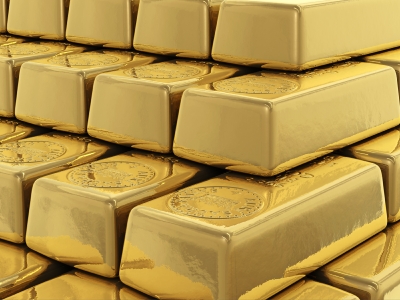Technical signals indicate precious metal may be less precious in the next few days
Gold's rally to a record near $1,900 an ounce pushed the metal to overbought levels according to technical analysis tools, as economist Dennis Gartman said prices will go “parabolic.”
Bullion's relative strength index has topped 70 since Aug. 5, a signal to some investors who study technical charts that prices may be set to decline. Gold hugged its upper Bollinger band most of this month, which may signal possible resistance, while a moving average convergence/divergence indicator and Elliot Wave patterns suggest prices are overextended, said Ross Norman, chief executive officer of London bullion brokerage Sharps Pixley Ltd.
Bullion climbed as high as $1,894.80 an ounce in London today and is up 16 percent in August, set for the best monthly gain since 1999. The metal has advanced as concern about debt crises and slower economic growth spurred investors to diversify holdings away from equities and some currencies. The biggest gold-backed exchange-traded product surpassed its equities counterpart as the largest by market value, while bullion rose to record prices in euros, British pounds and Swiss francs.
Set to Drop?
“I think we're overextended in the short term,” Axel Rudolph, a technical strategist at Commerzbank AG in London, said by phone. “I wouldn't be surprised if we were to fail around $1,900 to $1,922 and retrace a little bit for a few days or so. It's still very bullish longer term. Longer term, I think $2,000 will definitely be hit.”
Prices may slip to the Aug. 11 high of about $1,815 an ounce if gold stays below $1,925, which is near a 60-minute point-and-figure target, Rudolph said. The metal may move “sideways to up” if no decline takes place in the next couple of days, he said.
Still, a weekly close above $1,900 an ounce may push prices to the “psychological” level of $2,000, near the 200 percent extension of the rally from January's low to May's high projected from the May low, one of the levels singled out in so- called Fibonacci analysis, he said. Fibonacci analysis is based on the theory that prices tend to drop or climb by certain percentages after reaching a high or low.
Since 1920
Immediate-delivery bullion gained 1.6 percent to $1,882.05 an ounce by 5:21 p.m. in London. It's up 32 percent this year and heading for an 11th straight annual gain, the longest winning streak since at least 1920. The metal has outperformed global equities, commodities and Treasuries this year.
“Gold is strong in any and all currency terms, and it is now entering that stage when prices go parabolic,” Gartman said today in his Suffolk, Virginia-based Gartman Letter. “This will end when it ends; there is really nothing more that can or shall or should be said.”
Speculative demand from investors has pushed the gold market into a “bubble that is poised to burst,” Wells Fargo & Co. said in an Aug. 15 report. Prices may climb to $2,000 an ounce by the end of the year, according to the median forecast in a Bloomberg survey of 13 traders and analysts at a conference in Kovalam in South India on Aug. 20.
‘Panic Phase'
The precious metal's “rally when by rights a period of consolidation or profit-taking would be expected suggests that gold is either simply not in technical ‘mode' and that other external factors are driving us higher, or that we are in a panic phase which inevitably leads to a blow-off at the top,” Sharps Pixley's Norman said.
Demand for gold pushed holdings in ETPs to a record 2,216.8 metric tons on Aug. 8, data compiled by Bloomberg show. Investors' assets in the products were 2,211.1 tons on Aug. 19, more than all but four central banks. Central banks are also adding to gold reserves for the first time in a generation.
The market capitalization of the SPDR Gold Trust, the biggest gold-backed ETP, rose to $76.7 billion on Aug. 19, according to the most recent data compiled by Bloomberg. SPDR S&P 500 ETF Trust, which had been the industry's largest ETP since 1993, was at $74.4 billion.
Bullion's 14-day RSI, last at 82.67, reached 84.96 on Aug. 10, the highest level since October, according to data compiled by Bloomberg. Prices fell as much as 7.3 percent in the week after the gauge was at 84.61 on April 29 and traded in a $115 range for the next 2 1/2 months.
“You can actually make forecasts, even if it's trading at new all-time highs,” Commerzbank's Rudolph said. “The problem with gold right now is that in the last three days it's just accelerated higher, and when it's in this sort of move, it can still continue in fast spikes. It's very difficult to know where the spikes are going to end.”
--Bloomberg News--







